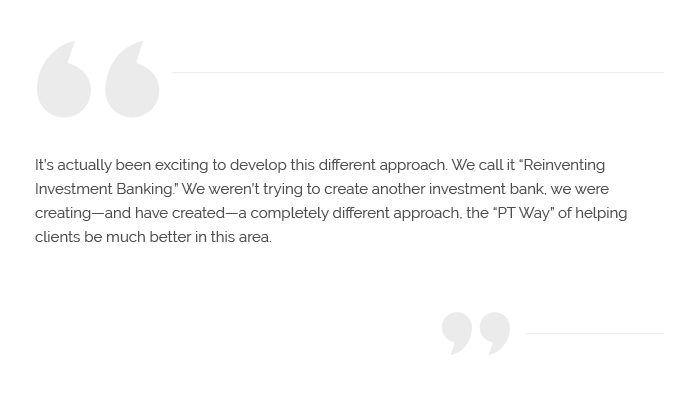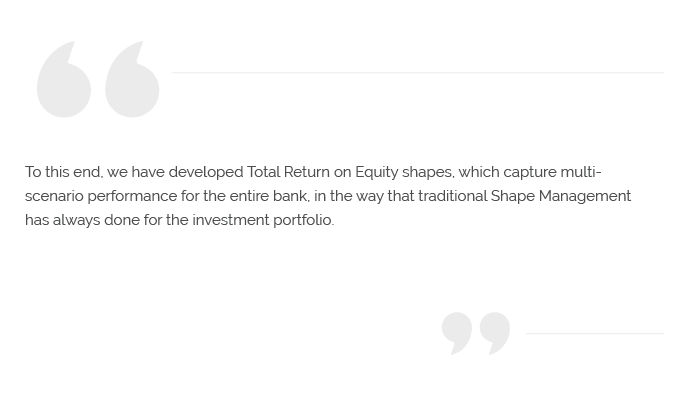As you know, I love good quotes. They're better than a cup of coffee. One of the maxims we've held close over the past two-and-a-half decades is attributed to the incredible physicist, Albert Einstein. He declared that "Everything should be made as simple as possible, but not simpler." What does that mean? For us, it means reducing investment decisions down to three simple but essential factors I have discussed at length in previous posts: time, money, and interest rate scenarios. This satisfies the first half of Einstein's rule. We also believe that eliminating any one of those three components would violate the second half of his directive, but not simpler.
One of the great puzzles that we faced throughout our first 20 years working with banks and credit unions was the investment banking side of things. To us, that industry didn't seem to follow these foundational concepts. If I'm honest, I also had a personal bias against the professional "investment banker" type: fashionable dresser, slicked-back hair, expensive suits. You know the type.

However, it turns out I was short-sighted and perhaps just a
wee bit biased. It took me a while, but as I mentioned a couple of weeks ago,
Charles Schulz had it right: "Life is like a 10-speed bicycle—most of us have
gears we never use." It turns out that one of the most famous bankers in
history said something very similar to Einstein. Reportedly, J.P. Morgan
operated by his own maxim: "No problem can be solved until it is reduced to
some simple form." Are you starting to see a theme here? Our firm needed help
to switch to our unused gear, the one that helped us translate investment
banking into the three simple concepts of time, money, and interest rate scenarios—but
not further—and then use that gear to communicate those ideas to help bankers
make better decisions in that part of their business as well. That help came to us in Daryle DiLascia. He
and his team have translated the investment banking problem into a decision
making framework built on the same disciplines as Shape Management®. Happily, I've
been able to grab a few minutes of his time to interview him on this
experience.
Q: As you know, I
firmly believe that none of us is able to predict the future. When dealing with
the investment or liability portfolios, we can often model a variety of
scenarios for banks/credit unions in order to help them make strategic
decisions based upon the best available fact set. Does this approach lend
itself to the investment banking arena?
A: Absolutely. A disciplined approach to decision-making is
critical, whether in managing the investment portfolio day to day or in the
Boardroom. Our analytical principles were intentionally codified generally
enough to apply across the entire bank, even if their initial application was focused
on the securities portfolio. So, opening a new branch, divesting from a
business line, raising capital, or acquiring another bank are all examples of the
Finance of Banking™ initiatives that can be examined under the same principles.
Each can be represented by a series of cash flows that are subject to change
based on a variety of internal and external factors. Understanding which things
can be under your control, and defining scenarios to capture the variable
effects outside of your control, can turn your financial projections into a framework that can lead to better and more confident decisions.
A greater number of variables are at play when contemplating
broader strategies than security selection, but Shape Management still provides
uniquely valuable insights, allowing key decision-makers to objectively expose blind
spots, fairly compare alternatives, and drive net future value for all
stakeholders. The addition of PT Score® also allows us to take an even more
comprehensive approach, utilizing its regulatory and structural risk lens to
view and influence strategic decisions in terms of both risk and reward.

It's actually been exciting to develop this different
approach. We call it "Reinventing Investment Banking." I've been working with
banks for almost 25 years, and trust me, I didn't think the world needed
another investment banking firm focused on depository institutions. However,
when I got to first know, then collaborate with, Performance Trust, I came to
realize we weren't trying to create another investment bank, we were creating—and
have created—a completely different approach, the "PT Way" of helping clients
be much better in this area.
Q: The industry
appears to be very well-capitalized, relative to where it was before the global
financial crisis. What has driven the record subordinated debt and preferred
issuance we've seen in 2020?
A: Issuers are being proactive. The future is always
uncertain, but right now it's particularly unclear. The pandemic has caused
economic stress, which forebodes higher credit costs. Yet historically-low
interest rates are compressing net interest margins as assets mature and are repriced
lower, for who knows how long. Both of these issues put pressure on
profitability, making it increasingly important to utilize balance sheet
strategies to provide insurance for sustainability while maintaining
optionality for opportunity.
At the same time and for some of the same reasons, it's
difficult for investors to find attractive yields on investments, making sub
debt and preferred equity relatively attractive compared to available
alternatives. This investor demand allows banks to access capital at a
reasonable cost, fortifying their balance sheets and, in some cases, leveraging
that capital into strategies to mitigate expected earnings headwinds.
This is another area where we're applying Shape Management® and
leveraging the lens of PT Score for both issuers and investors. From the
issuer's perspective, it starts with understanding how the current balance
sheet behaves in multiple future scenarios. To assist banks through this
process, we've developed the Balance Sheet Look-Forward ("BSLF") tool, which
helps identify both risks and opportunities that exist based on looking at
various possible futures as a set. We also utilize PT Score to run stress
simulations on the loan portfolio, with a particular focus on how regulatory
capital ratios hold up in adverse credit environments. This helps us establish
a baseline view of capital adequacy, which can then inform decisions around
accessing additional capital. These same tools help us frame the multi-scenario
investment decision for capital providers, helping them consider opportunities
by asking the question, "compared to what?"
Q: Publicly-traded
bank stocks are trading at depressed valuations. What is the market
anticipating and how can we advise banks to navigate uncertainty ahead?
A: The market is reasonably efficient and can see that time
is not on the industry's side. If the environment remains static, some of the
profitability pressures I've mentioned will naturally occur with the passage of
time. For certain banks, the baseline cost of operations is sufficiently high
that they will not be able to earn the required rates of return on equity capital
if they haven't taken decisive action in time. This leads to a lower valuation
on publicly-traded equities, given that it's more difficult for investors to
confidently forecast future earnings in these circumstances. Tangible book
value usually acts as a governor on valuation, both to the upside and downside,
but that safety net becomes less reliable when a risk of credit deterioration
is looming offstage.
I've mentioned that we're working with banks to identify
balance sheet strategies to mitigate some of these potential earnings pressures.
Another way to drive operational efficiency is to acquire another bank,
reducing the combined cost infrastructure, and creating economies of scale. I
fully expect that once we find equilibrium within a "new normal" environment, wherever
that is, consolidation will escalate. Helping banks earn their independence is
core to our mission, but that can mean several things. It might mean
organically achieving sufficient risk-adjusted returns to support ongoing
independence. It could also mean growing through acquisition, or agreeing to
merge with a larger institution from a position of strength. It's really about
controlling your own destiny through performance, while always maintaining
regulatory good standing.

To this end, we have developed Total Return on Equity Shapes,
which capture multi-scenario performance for the entire bank, in the way that
traditional Shape Management has always done for the investment portfolio. This
allows us to holistically craft better advice for banks in pursuit of both
organic and strategic growth opportunities. In any environment, there are
things that could occur in the future that will be outside of our control. In considering
merger or acquisition strategies, it's particularly important to understand those
things that are knowable, about your
own bank as well as about the prospective combined institution.
Given current equity valuations, it may also become
attractive for publicly-traded banks to buy back their own stock. We like to
think of this as an acquisition without as much execution risk. Because the
future is so unclear, banks have been rightly reluctant recently to reduce
capital through share repurchases, but that's where optionality can come in
handy. Some of the sub debt and preferred issuers we've worked with are
profitably utilizing excess capital today while retaining the optionality necessary
to be able to unwind balance sheet strategies and optimize the capital
structure through the repurchase of common equity in the future if desired. Equity
prices will naturally increase as visibility improves, but price and value are
different things, and our framework helps banks identify value, and
opportunities when this differs from price.
I want to thank
Daryle for taking this time with us. Remember, as J.P. Morgan said so many
years ago,"No problem can be solved
until it is reduced to some simple form." If you are anything like me, I can
sometimes do just the opposite, turning what should be a simple decision into a
confusing morass.Daryle and his team,
however, follow a disciplined process to help turn seemingly very complex
decisions into straightforward scenario-based frameworks—simple forms.


